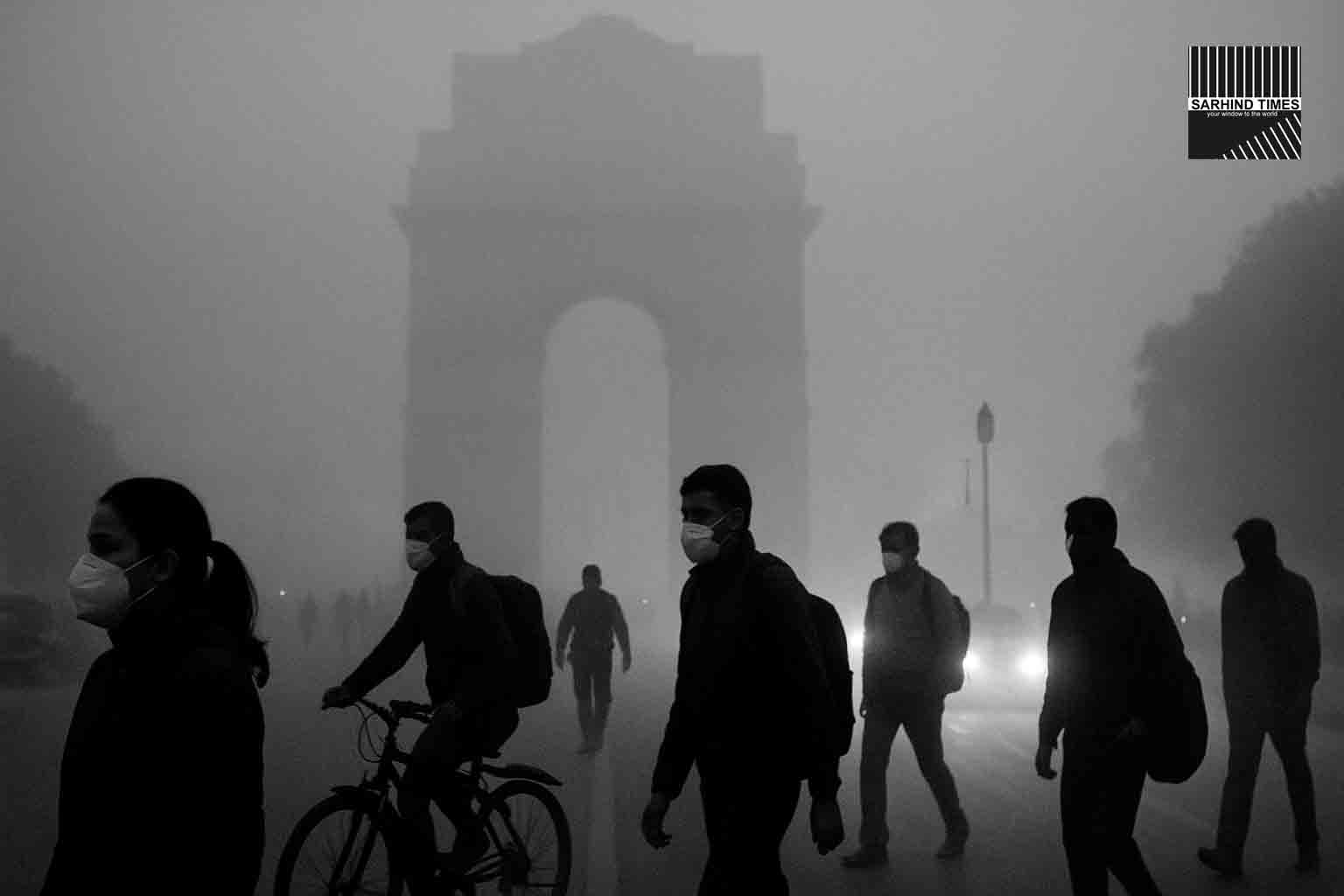A brief window of relief lifted Delhi’s AQI into the ‘moderate’ range this weekend, but forecasts predict renewed deterioration from midweek as winds weaken and stubble-burning picks up across north India.
Breezy conditions have temporarily improved Delhi’s air quality, with AQI levels hovering in the ‘moderate’ zone on October 13–14. However, model projections from the Air Quality Early Warning System warn of a slide back to the ‘poor’ category starting October 15, driven by weakening wind speeds, dry weather, and early instances of stubble burning in Punjab and Haryana. Officials highlight that Delhi has recorded 199 “cleaner than poor” days this year—the best in a decade—crediting sustained mitigation under the winter action plan. Source: Hindustan Times.
🌤️ New Delhi, October 13 — A Breath of Relief Before the Smog Returns
For the first time this month, Delhi woke up to relatively clearer skies and measurable improvement in air quality over the weekend. The Air Quality Index (AQI), which had hovered between 160 and 180 for much of the past week, slipped into the ‘moderate’ bracket (101–200), thanks to persistent northwesterly winds that dispersed pollutants across the capital and adjoining regions.
But the reprieve, meteorologists warn, will be short-lived. Forecast models run by the Air Quality Early Warning System (AQEWS) and the Indian Institute of Tropical Meteorology (IITM) indicate that pollution levels are likely to climb again after October 15, pushing Delhi back into the ‘poor’ category (201–300) for at least five to seven days.
🌬️ Winds Bring Short-Term Relief
The turnaround in Delhi’s air quality was primarily driven by wind speeds averaging 10–15 km/h, coupled with dry conditions that allowed better vertical mixing of air layers.
According to data from the Central Pollution Control Board (CPCB), Delhi’s 24-hour AQI on Sunday averaged 147 (‘moderate’)—a marked improvement from 212 (‘poor’) recorded earlier in the week.
Stations across RK Puram, Anand Vihar, and Jahangirpuri, which usually top the pollution charts, also registered improvements, falling below the 200 mark for the first time in 10 days. Peripheral areas such as Gurugram, Noida, and Ghaziabad mirrored the trend, suggesting widespread dispersion aided by synoptic winds.
“The improvement is largely meteorological, not structural,”
— said Dr. Gufran Beig, founder project director of SAFAR (System of Air Quality and Weather Forecasting and Research).
“As soon as the wind slows, accumulation will begin again.”
📉 Forecast: Poor Air to Return After October 15
Model forecasts from AQEWS suggest a reversal starting midweek. Wind speeds are expected to drop to below 6 km/h, and temperatures will begin their post-monsoon decline, reducing vertical mixing height — conditions ripe for pollutant buildup.
The system projects the AQI may worsen to 230–280 (‘poor’ range) between October 15 and 21, with localized spikes expected during evening traffic hours and early morning inversion layers.
Key contributing factors identified include:
- Dust resuspension from construction zones.
- Early stubble burning in Punjab and Haryana.
- Festive emissions, particularly from vehicular congestion and lighting activity.
“Model guidance indicates that the Delhi-NCR basin will experience weaker dispersion and pollutant trapping at lower altitudes,” said a senior AQEWS scientist. “This is a textbook transition toward the winter phase of pollution.”
🌾 Stubble Burning Season Begins
Satellite images from the Indian Agricultural Research Institute (IARI) have detected a gradual uptick in farm fire incidents across Punjab and Haryana, signaling the onset of the stubble-burning period that typically peaks in late October.
Between October 1 and 12, IARI recorded 427 fire counts, up from 296 during the same period last year. Most of these were concentrated in Amritsar, Tarn Taran, and Patiala districts.
The Punjab Pollution Control Board (PPCB) has deployed 700 enforcement teams to curb the practice, but field reports suggest that ground implementation remains uneven. Farmers continue to cite high straw management costs, low bio-decomposer availability, and tight sowing schedules as barriers to compliance.
“Without sustained financial support, it’s unrealistic to expect zero burning,”
— said Balbir Singh, a farmer from Sangrur district.
Each year, the smoke from these fires drifts toward the Indo-Gangetic plains, mixing with urban emissions and contributing up to 30% of Delhi’s PM2.5 levels during peak episodes.
🏛️ Government Response: ‘Action Plan Working, But Vigilance Needed’
The Commission for Air Quality Management (CAQM) and the Delhi government have both issued statements highlighting the temporary success of mitigation measures under the Winter Action Plan, while cautioning that the seasonal transition requires heightened vigilance.
Officials noted that Delhi has recorded 199 “cleaner than poor” days so far this year — the highest since 2016, when continuous air-quality monitoring began.
Key measures credited include:
- Mechanical road sweeping and anti-dust campaigns.
- Intensified inspection of construction sites.
- Expansion of electric bus fleet under DTC and cluster services.
- Pusa bio-decomposer spraying to manage stubble residue within Delhi’s own farms.
“We are seeing the benefits of year-round work, not just winter firefighting,”
— said Gopal Rai, Delhi’s Environment Minister.
“But meteorology remains a major determinant, and citizens must stay alert.”
🚦 Traffic, Firecrackers, and the Festive Factor
With the Navratri and Diwali season approaching, experts warn that vehicular density, construction rush, and the perennial firecracker debate could aggravate pollution levels.
Traffic data from the Delhi Traffic Police shows peak congestion returning to pre-pandemic levels, with over 13 million registered vehicles in the capital region.
The Delhi government has already indicated that restrictions on firecracker sales and use will continue this year. The GRAP (Graded Response Action Plan) mechanism, which mandates tiered restrictions based on AQI levels, is expected to activate Stage I (poor) by next week.
“We anticipate the first GRAP trigger around October 16–17 if models hold true,”
— said an official from CAQM.
Stage I actions include:
- Ban on coal and firewood in eateries.
- Intensified street watering.
- Strict dust-control enforcement.
- Public advisories against prolonged outdoor exposure.
🌫️ The Meteorological Context: Transition Toward Winter Inversion
Meteorologists describe the October transition as a critical inflection period in Delhi’s atmospheric cycle.
As monsoon withdrawal concludes and nighttime temperatures begin to drop, thermal inversion layers form closer to the surface, trapping pollutants within the lower troposphere. Combined with declining wind speeds and increased vehicular emissions, this sets the stage for the annual smog buildup.
The India Meteorological Department (IMD) projects continued dry conditions and gradual cooling over the next 10 days, further lowering mixing height — a key determinant for dispersion efficiency.
“It’s a seasonal inevitability, but its intensity depends on anthropogenic control,”
— said Mahesh Palawat, VP (Meteorology), Skymet Weather.
🧪 Pollution Composition: PM2.5 Dominates
Data from CPCB monitoring stations shows PM2.5 as the dominant pollutant, accounting for 52–65% of total particulate load. Other significant contributors include PM10, NO₂, and CO, with ozone levels remaining within permissible limits.
The PM2.5 concentration on October 13 averaged 88 µg/m³, nearly three times the WHO safe limit (25 µg/m³) but lower than last week’s 145 µg/m³.
Health experts reiterate that even “moderate” levels can aggravate respiratory and cardiac conditions, particularly in children and the elderly.
“There’s no ‘safe’ pollution level for vulnerable groups,”
— warned Dr. Arvind Kumar, Chair of the Centre for Chest Surgery, Medanta.
“The current respite should not breed complacency.”
🏥 Public Health Advisory
The Delhi Pollution Control Committee (DPCC) and Safdarjung Hospital have jointly issued updated public health guidelines for the upcoming week:
- Avoid early morning outdoor exercise.
- Use N95 masks in traffic-heavy zones.
- Employ air purifiers indoors if possible.
- Keep windows closed during evening peak hours.
- Monitor AQI updates daily via CPCB and SAFAR apps.
The Delhi Health Department has also directed hospitals to prepare for seasonal upticks in asthma, COPD, and bronchitis cases.
Last year, outpatient respiratory visits surged by 32% during the October–November period.
📊 Data Snapshot: Delhi Air Quality Trends (Jan–Oct 2025)
| Category | AQI Range | Days Recorded |
| Good (0–50) | 0 | — |
| Satisfactory (51–100) | 42 | |
| Moderate (101–200) | 157 | |
| Poor (201–300) | 112 | |
| Very Poor (301–400) | 48 | |
| Severe (401+) | 6 |
(Data: CPCB consolidated report as of October 12, 2025)
If trends continue, Delhi could close 2025 with fewer “severe” days than any year since 2018, a metric the government cites as evidence of gradual structural improvement.
🛠️ Policy Lens: From Reactive to Predictive Governance
Delhi’s environmental governance has evolved from reactive measures to predictive monitoring, leveraging satellite data, machine learning forecasts, and multi-agency coordination.
Key policy innovations this year include:
- Real-time inter-state fire monitoring dashboard.
- AI-based dust hotspot mapping for PWD projects.
- 24×7 GRAP command center with predictive AQI analytics.
Experts call it a maturing framework, though enforcement gaps persist.
“The science is sound; the challenge is compliance,”
— said Anumita Roychowdhury, policy director at the Centre for Science and Environment (CSE).
“Local enforcement and public accountability must deepen.”
🌏 Beyond Delhi: A Regional Problem
Delhi’s pollution problem is not contained within its borders. The National Capital Region (NCR) — including Gurugram, Noida, Faridabad, and Ghaziabad — contributes significantly through vehicular emissions, industrial clusters, and construction activities.
The CAQM’s NCR-wide jurisdiction has improved coordination, but inter-state blame games continue.
“The airshed doesn’t recognize political boundaries,”
— said Rakesh Agrawal, senior scientist at CPCB.
“Solutions have to be regional, not city-specific.”
🧭 Public Participation: The Missing Link
Despite awareness campaigns, citizen compliance remains uneven. Illegal garbage burning, idling vehicles, and use of diesel generators persist across neighborhoods.
NGOs like Clean Air Collective and Help Delhi Breathe have urged community-level monitoring and citizen reporting apps.
“Technology enables accountability, but public will sustains it,”
— said Ritika Anand, environmental activist.
The Delhi government’s Green War Room continues to receive over 1,200 daily complaints on its mobile app, though disposal rates vary.
🔚 Conclusion: The Calm Before the Smog
Delhi’s brief spell of cleaner air offers momentary relief — but also a reminder of the fragility of its environment. The city’s fight for breathable air has become an annual test of policy endurance, meteorological fortune, and civic discipline.
As winds slow and stubble fires rise, the capital once again braces for a familiar, murky horizon. The data may show improvement, but the lived experience of millions will depend on one question: can short-term weather luck evolve into long-term systemic change?
For now, the answer drifts — like Delhi’s dust — in the wind.
#DelhiAQI #AirPollution #Environment #CleanAir #StubbleBurning #PublicHealth #Smog #SarhindTimes






















+ There are no comments
Add yours